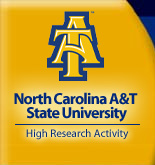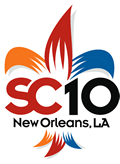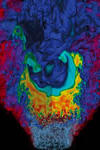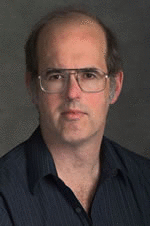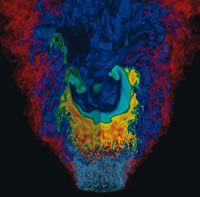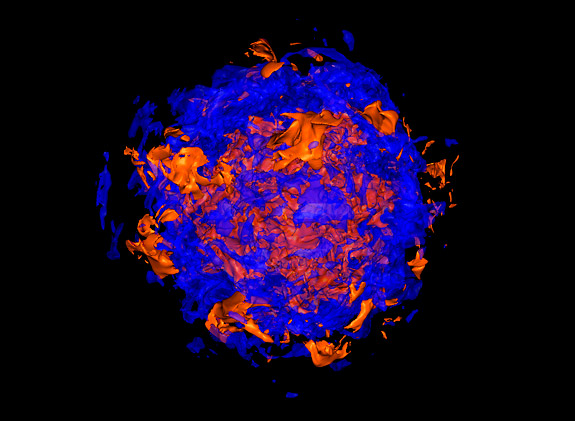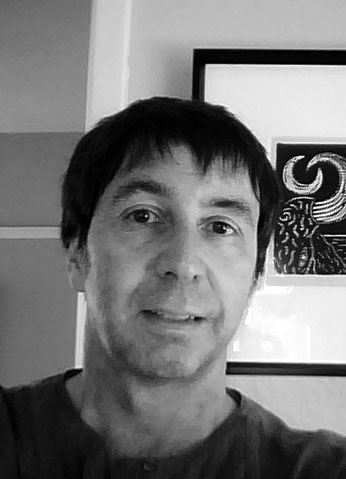
December 2010 News
2011 INCITE Awards -- CCSE and Collaborators Awarded 90 Million Hours
U.S Energy Secretary Steven Chu today announced the largest ever awards of the Department's supercomputing time
to 57 innovative research projects. CCSE and collaborators earned two of these coveted awards.
The first award, titled "Simulation of Turbulent Lean Hydrogen Flames in High Pressure", with PI John Bell and
Co-I Marc Day, was awarded 40 million hours. The second award, titled "Petascale Simulations of Type Ia Supernovae
from Ignition to Observables", with PI Stan Woosley of UCSC and Co-I's John Bell and Mike Zingale of Stony Brook University,
was awarded 50 million hours. The average allocation was 27 million hours.
"The Department of Energy's supercomputers provide an enormous competitive advantage for the United States," said Secretary Chu. "This is a great example of how investments in innovation can help lead the way to new industries, new jobs, and new opportunities for America to succeed in the global marketplace."
|
|
|
|
CCSE Code Plays a Key Role in NSF-Funded HBCU-RISE AMCA Center
In 2006, when
Yevgenii Rastigejev was a postdoc at Northwestern University, he used
CCSE's IAMR code as the framework for a level set method he developed to
study the nonlinear development of hydrodynamically unstable premixed flames.
Fast-forward a few years and Dr. Rastigejev is now Professor Rastigeyev, an
assistant professor with a joint appointment in the Dept. of Mathematics and in
Energy and Environmental Studies at
North Carolina A&T State University. He, with his collaborator, Dr. Tang,
have just been awarded a $1M HBCU-RISE grant by NSF to fund
a three-year research mini-center, the
Center for Advanced Multi-scale Computational Algorithms (AMCA).
A key part of the proposal involves using AMR methods for atmospheric chemical
transport modeled by advection-diffusion-reaction equations. For this part, the
new center will use an adaptive advection code developed by CCSE, and based on the
common software framework shared by
IAMR and
CASTRO. In addition, CCSE will
collaborate with the new center in the training of students on adaptive mesh methods
for solving the advection/diffusion/reaction equations.
|
November 2010 News
CCSE Visualizations Prominently Featured as Live Demos in the
Berkeley Lab's Booth at SC10
Four of these movies can already be seen on the
CCSE's
web page. These include movies made from simulations using CCSE's
CASTRO
and
MAESTRO
software, that are being shown on the 24-inch Magic Planet globe at SC10.
In addition, the movies of buoyant burning bubbles in Type Ia supernovae and of
turbulent jets with off-source heating will be shown as live demos.
Finally, a new movie courtesy of LBL's David Camp and Hank Childs, based on simulations
by Jason Nordhaus and Adam Burrows of Princeton University as well as Ann Almgren
and John Bell of CCSE, is available to see
here.
|
|
|
|
What Do These Postcards Have In Common?
One is called "Supercomputers Dissect the Fiery Death Throes of a Dying Star to Understand the
Origin of the Elements, Pulsars and Black Holes?"
The other is titled "Supercomputers Peer Into the Heart of a Flame to Help Scientists Build More Fuel-Efficient
Burners."
What do they have in common?
The answer is
CCSE.
These are two of the four colorful Computing Sciences postcards being given out at Berkeley Lab's SC10 booth.
Each card features Department of Energy sponsored science results that were powered by NERSC supercomputers.
The supernova postcard shows results of a simulation performed by Jason Nordhaus
and Adam Burrows at Princeton University using CCSE's
CASTRO code.
The combustion postcard shows a simulation by CCSE's own Marc Day, John Bell and Mike Lijewski.
|
October 2010 News
|
|
From iSGTW:
When large stars die out and collapse, they explode, creating a supernova.
But when scientists attempted to simulate this process, they got a "fizzle" instead of a "bang."
Until now, scientists simply assumed that there is something fundamental about the physics of supernovae
that we didn't understand.
Now scientists may have cracked the problem by using a new approach to create computer simulations of supernovae.
"The new simulations are based on the idea that the collapsing star itself is not sphere-like,
but distinctly asymmetrical and affected by a host of instabilities in the volatile mix surrounding its core"
explained a recent press release. "Writing in the Sept. 1 issue of the Astrophysical Journal,
Jason Nordhaus and Adam Burrows of Princeton University, and the Lawrence Berkeley National Laboratory's
Ann Almgren and John Bell report that the new simulations are beginning to match the massive blow-outs
astronomers have witnessed when gigantic stars die."
Although jokes are often told about the physicist's propensity for assuming everything is a sphere,
they do this with good reason: more complex models are costly to simulate, in terms of computational resources.
This research was conducted on the National Energy Research Scientific Computing Center's Cray XT4 Franklin system,
using CASTRO, a program developed by Almgren and Bell, and according to the press release, it wouldn't have been
possible without access to a high performance computing facility.
For more information, visit the
original press release.
|
John Bell Gives Invited Talk at Courant Institute
John Bell is giving an invited talk on Friday, October 29, at the
Courant Institute of Mathematical Sciences in New York City.
His talk is titled "Low Mach Number
Models in Computational Astrophysics" and discusses work by Bell and others on
developing and using a low Mach number model for astrophysical flows. For more
information about the low Mach number model and the code based on it, see the
MAESTRO page.
|
|
|
|
Two of seven stories on
Computational Research for the Environment at LBL
feature CCSE research. The first, titled "Carbon Goes Underground, Then What?
3-D Simulations Shed Light on Fate of Geologically Sequestered CO2", discusses
research by George Pau and John Bell on carbon sequestration. The second, titled
"Experiments and Simulations Join Forces to Engineer a New Type of Clean, Efficient Burner"
discusses recent work by John Bell and Marc Day, in collaboration with Robert Cheng.
|
September 2010 News
|
Most stars end their lives in a whimper - our own sun will almost certainly be one of them -
but the most massive stars go out with an impressive bang. When that happens, creating what's
known as a Type II supernova, the associated blast of energy is so brilliant that it can briefly
outshine an entire galaxy, give birth to ultra-dense neutron stars or black holes, and forge atoms
so heavy that even the Big Bang wasn't powerful enough to create them. If supernovas didn't exist,
neither would gold, silver, platinum or uranium. The last time a supernova went off close enough to
earth to be visible without a telescope, back in 1987, it made the cover of TIME....
more
|
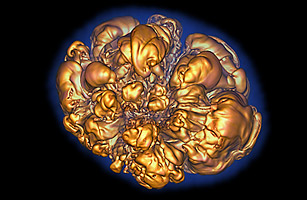
|
Photo courtesy of Hank Childs, LBNL
|
|
|
|
For scientists, supernovae are true superstars -- massive explosions of huge, dying stars that shine light
on the shape and fate of the universe. Recorded observations of supernovae stretch back thousands of years,
but only in the past 50 years have researchers been able to attempt to understand what's really happening
inside a supernova via computer modeling. These simulations, even crude ones, can lead to new information
about the universe's size and eventual fate and help address longstanding problems in astrophysics.
Now, researchers from Princeton University and the Lawrence Berkeley National Laboratory have found
a new way to make computer simulations of supernovae exploding in three dimensions.
The new simulations are based on the idea that the collapsing star itself is not sphere-like,
but distinctly asymmetrical and affected by a host of instabilities in the volatile mix surrounding its core.
Writing in the Sept. 1 issue of the Astrophysical Journal, Jason Nordhaus and Adam Burrows of
Princeton University, and the Lawrence Berkeley National Laboratory's Ann Almgren and John Bell
report that the new simulations are beginning to match the massive blow-outs astronomers have witnessed when gigantic stars die...
more
|
August 2010 News
|
|
Aspden and Day present at the 33rd International Symposium on Combustion
Andy Aspden
and Marc Day
are presenting three papers at the 33rd International Symposium on Combustion
being held in Beijing, China, August 1-6.
|
|
Aspden is presenting "Characterization of Low Lewis Number Flames"
and "Lewis Number Effects in Distributed Flames",
both co-authored with Marc Day and
John Bell of CCSE.
Day is presenting "Numerical Simulation of Nitrogen Oxide Formation in Lean Premixed Turbulent Flames",
co-authored with
John Bell and
Xinfeng Gao of CCSE,
and Peter Glarborg of the Technical University of Denmark.
|
July 2010 News
Almgren and Day participate in Computing Sciences Outreach to Local High School Students
Marc Day and Ann Almgren gave presentations about their work on combustion and astrophysics
to local high school students on Thursday, July 29, as part of an outreach program to introduce students to
various career options in scientific computing and networking. The program was developed with input from
computer science teachers at Berkeley High, Albany High, Kennedy High (in Richmond), and Oakland Tech.
|
|
|
Bell presents at the SciDAC 2010 Conference
John Bell presented two CCSE posters the
SciDAC 2010 Conference
held July 12-16, 2010, in Chattanooga, Tennessee. The posters were
- MAESTRO, CASTRO, and SEDONA: Petascale Codes for Astrophysical Applications,by
Ann Almgren, John Bell, Mike Lijewski, Andy Nonaka, Peter Nugent, and Rollin Thomas of CRD;
Daniel Kasen of UC Santa Cruz; Charles Rendleman of D. E. Shaw Research; and Michael Zingale of Stony Brook University
and
- Simulation of Nitrogen Emissions in a Low Swirl Burner,by
John Bell, Marc Day, Xinfeng Gao, and Mike Lijewski of CRD
|
CAC Movie Wins "OASCR" at SciDAC 2010 Visualization Night
At this same meeting, CCSE collaborators won an "OASCR" at the SciDAC 2010 Visualization night
for "Type Ia Supernova: Turbulent Combustion at the Grandest Scale," which was produced for the
SciDAC Computational Astrophysics Consortium by the NERSC Analytics Team and VACET, with Hank Childs in the lead.
Calculations using the CASTRO code were run on Franklin at NERSC and Jaguar at OLCF by Haitao Ma and
Stan Woosley of UC Santa Cruz, and John Bell, Ann Almgren, and Andy Nonaka of CCSE. Here is a summary:
Deep inside a dying star in a galaxy far, far away, a carbon fusion flame ignites.
Ignition may happen in the middle or displaced slightly to one side, but this simulation explores the consequences
of central ignition. In a localized hot spot, represented here by a deformed sphere with an average radius of 100 km,
carbon is assumed to have already fused to iron, producing hot ash (~10 billion K) with a density about 20% less than
its surroundings. As the burning progresses, this hot buoyant ash rises up and interacts with cold fuel. Rayleigh-Taylor
fingers give rise to shear and turbulence, which interacts with the flame, causing it to move faster. In about 2 seconds,
the energy released blows the entire white dwarf star up, leaving nothing behind but a rapidly expanding cloud of
radioactive nickel, iron, and other heavy elements. A Type Ia supernova is born.
|
Pau presents at the Gordon Research Conference
George Pau presented a talk titled "High Resolution Simulation of
Flows Encountered in Geologic CO2 Sequestration" at the
Gordon-Kenan Research Seminar on Flow and Transport in
Permeable Media held in Lewiston, Maine on July 10-11, 2010. He also
presented a poster titled "Adaptive Mesh Refinement for
Two-Phase Compressible Flow in Porous Media" at the
Gordon Research Conference on Flow and Transport in
Permeable Media held at the same location on July 11-16,
2010.
|
|
May 2010 News
|
|
Aleksandar Donev Speaks at SIAM Meeting on Mathematical Aspects of Materials Science
Alvarez Fellow Aleksandar Donev
gave an invited talk in the minisymposium on Coarse-Grained Stochastic Models in
Soft Condensed Matter on Sunday, May 23.
His talk was titled, ``A Hybrid Particle-Continuum Method for Hydrodynamics of
Complex Fluids,'' and discussed joint work with
John Bell,
Alejandro Garcia, and Berni Alder.
Donev was also an organizer of the two-part minisymposium series.
|
CCSE People and Codes Featured at SciDAC Computational Astrophysics Consortium Meeting
Nine of the talks at the
SciDAC Computational Astrophysics Consortium Meeting
held May 19-21, 2010, featured speakers and/or codes from CCSE.
Talks were given by CCSE members,
and by CCSE collaborators,
- Louis Howell -- Radiation transport in CASTRO
- Mike Zingale -- Ignition of Type Ia Supernovae using MAESTRO
In addition, collaborators Haitao Ma, Candace Joggerst, Ken Chen
and Adam Burrows gave talks about their 3D simulations
using CASTRO.
Both
MAESTRO and
CASTRO are
codes developed in CCSE as part of the SciDAC Computational Astrophysics Consortium.
CCSE Presence at 2010 DOE Applied Mathematics Program Meeting
With a total of six contributions -- two talks and four posters --
CCSE was well represented at the 2010 DOE Applied Mathematics Program Meeting,
held May 3-5, 2010, in Berkeley, CA.
Talks were given by
- Andy Nonaka --
AMR for Low Mach Number Modeling of Stratified Flows (joint with
Ann Almgren, John Bell, Mike Lijewski, Mike Zingale, Chris Malone)
- Aleksandar Donev --
On the Accuracy of Finite-Volume Schemes for Fluctuating Hydrodynamics.
(joint with John Bell, Alejandro Garcia, Eric Vanden-Eijnden, Jonathan Goodman)
Posters were presented by
- Andrew Aspden
--Convective Pattern Formation During Rotation Spin-Up,
- Marc Day
-- Transition from Cellular to Distributed
Burning in Lean Hydrogen-Air Flames (joint with John Bell and Andrew Aspden),
- Alejandro Garcia
-- A Hybrid Particle-Continuum Method for Hydrodynamics of Complex Fluids,
(joint with Aleksandar Donev, John Bell and Berni Alder)
- George Pau
-- High Resolution Simulation and
Characterization of Flows Encountered in Geologic CO2 Sequestration (joint
with John Bell, Karsten Pruess, Ann Almgren and Mike Lijewski)
April 2010 News
CASTRO Poster Wins MSI Poster Award
The poster
by Ke-Jung Chen, Alexander Heger,
Ann Almgren
and Shuxia Zhang,
"Simulations of Thermonuclear Supernovae of Very Massive Stars,"
was one of the winners in the MSI 25th Anniversary Research Exhibition poster contest.
February 2010 News
|
|
Ann Almgren Speaks at SIAM Conference on Parallel Processing and Scientific Computing
Ann Almgren
gave an invited talk in the Parallel Computing of Fluids and Interfaces
minisymposium at the SIAM Conference on Parallel Processing and Scientific Compouting (PP10) meeting
in Seattle on Thursday, February 25. Her talk was titled
``Parallel Adaptive Simulation of Low Mach Number Flows"
and discussed joint work with
John Bell,
Andy Nonaka.
and Mike Zingale.
|
Talk by Alvarez Fellow Aleksandar Donev at UC Berkeley
Alvarez Fellow Aleksandar Donev
gave an invited talk in the applied mathematics seminar at UC Berkeley on Thursday, February 4.
His talk was titled, ``A Hybrid Particle-Continuum Method for Hydrodynamics of
Complex Fluids,'' and discussed joint work with
John Bell,
Alejandro Garcia, and Berni Alder.
|
|
January 2010 News
|
|
Alvarez Fellow Aleksandar Donev Speaks at UC Santa Barbara
Alvarez Fellow Aleksandar Donev
gave an invited talk in the applied mathematics seminar at UC Santa Barbara
on Friday, Jan. 29. His talk was titled, ``A Hybrid Particle-Continuum Method for Hydrodynamics of
Complex Fluids,'' and discussed joint work with
John Bell,
Alejandro Garcia, and Berni Alder.
|
Bell and Garcia chosen to organize 2011 von Neumann Symposium
AMS has announced that the 2011 von Neumann Symposium will be "Multimodel and Multialgorithm Approaches to Multiscale Problems,"
organized by John Bell of CCSE and
Alejandro Garcia of
San Jose State University.
Multiscale problems are of increasing importance in the fields of physics, biology, chemistry, fluid dynamics,
environmental science, materials science, geophysics, and all branches of engineering. The symposium will bring
groups together in four key areas (fluids, solids, earth sciences, and molecular dynamics), and will enable applied mathematicians
and scientists to discuss current practices and future research directions in the development of hybrid methodologies for
multiscale phenomena. The AMS von Neumann Symposia are made possible by the generous support of a fund
established by Dr. and Mrs. Carrol V. Newsom in honor of the memory of John von Neumann. See
ams.org for the official annoncement.
|
|
Four posters on MAESTRO and CASTRO at January AAS Meeting


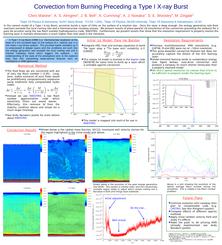
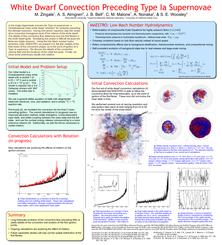
|
Andy Nonaka and
Ann Almgren of CCSE,
and Stony Brook University collaborators
Mike Zingale and
Chris Malone
presented four posters on MAESTRO and CASTRO at the recent American Astronomical Society (AAS)
Meeting in Washington D.C., January 3--7, 2010. Almgren's poster described the recent
code development of CASTRO and showed 3D results by collaborators Candace Joggerst and Jason Nordhaus.
Nonaka's poster described the code development of MAESTRO, while Zingale's and Malone's poster presented
results of recent MAESTRO simulations, one of rotating Type Ia supernovae and the other of
X-ray bursts. The pdf of each poster can be found by clicking on the image above.
Almgren participates in AWM Workshop Panel Discussion on Career Opportunities
On Saturday, January 16,
Ann Almgren
is speaking as an invited participant in an AWM "Career Opporuntities: The Early Years" panel.
The special panel is being held in San Francisco as part of the Joint Mathematics Meetings, January 13-16, 2010.
|
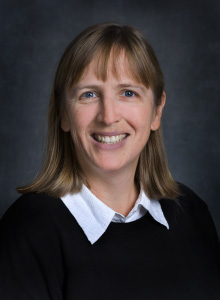
|
|









